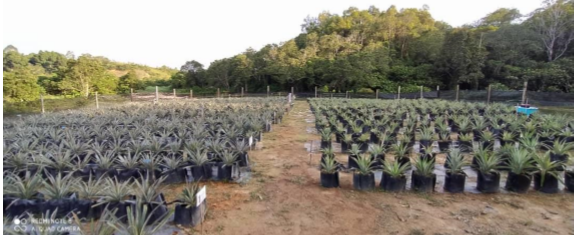C) Enhancement of flower induction in Sarawak local pineapples varieties induced by exogenous hormones
 Introduction:
Introduction:
This research group focuses on the use of plants as a source of food, energy, and fibre. We work on various aspects from genetics, plant physiology, meteorology to soil science. Our work progresses to secure a healthy and sustainable food supply for better livelihood.
Enhancement of flower induction in Sarawak local pineapples varieties induced by exogenous hormones
Pineapple (Ananas comosus) is an economically important horticultural crop with great health benefits. In 2016, the world production of pineapple fruit was 25.8 million metric tons and Malaysia’s contribution was with estimation of 315.977 metric tons and ranked it 19th pineapple producing country. Malaysian Pineapple Industry Board revealed Malaysian pineapples had become a new source of wealth for the country as its export value was expected to increase from RM155 million a year (NST Online, 2017). Sarawak state government also had identified pineapple have huge potential as a lucrative crop that contributes significantly to the state’s socioeconomic development (Star Online, 2018). Several local varieties of pineapple have been identified to be widely cultivated and high in demand at Sarawak are include Moris (Sarikei or Madu), Paun, N36 Gandul, Moris Gajah and Nanas Sawit (Pada) planted in 972.48 ha. A pineapple tree in a normal situation experiences self-bloom on the 12-18 month after it is planted. Environmental factors such as temperature, daytime period and the amount of sunlight reflection can trigger the formation of the natural flower. The rapid growth rate which is the result of the effects of excessive nitrogen, water flow or rain will prevent blossoming of flowers. Pineapple is a plant that aware of the chemical growth control ingredients such as NAA liquid, ethepone, acetyletheline. The success of blossoming flow is evaluated through the blossoming percentage which occurs after 45-60 days. Most of the hormoning techniques enhance the development of flowering had been only applied on MD2 cultivar by Malaysian Pineapple Industry Board. However, detail documentation on the application of flowering hormones towards Sarawak locally grown pineapple varieties are limited. Therefore, the aim of the study is to evaluate the development of inflorescence in locally Sarawak grown pineapple varieties induced by flowering hormones. This project was funded by Ministry of Higher Education Malaysia under the Fundamental Research Grant Scheme (FRGS) FRGS/1/2019/WAB01/UPM/02/18 / 07-01-19-2213FR.
 Pictures:
Pictures:

Figure 1 Planting plot of 900 3 months old pineapple plants in UPM Bintulu Campus for flowering hormones
 For more further enquiries:
For more further enquiries:
Dr. Noorasmah Binti Saupi
Senior Lecturer
Department of Crop Science
Faculty of Agricultural Science and Forestry
Tel: +6086 855394
Email: noorasmah@upm.edu.my
Updated:: 04/09/2020 [lanz]
MEDIA SHARING











 Introduction:
Introduction: Pictures:
Pictures:
 For more further enquiries:
For more further enquiries:


















